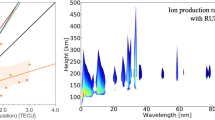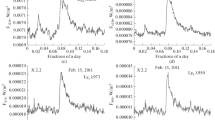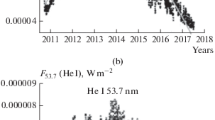Abstract
Studies in the extreme ultraviolet (EUV) and X-ray ranges of the solar spectrum are important due to the active role of radiation of these ranges in the formation of the Earth’s ionosphere. Photons of the EUV range are completely absorbed in the upper layers of the Earth’s atmosphere and induce the excitation, dissociation, and ionization of its different components and, finally, atmospheric heating. From the archive data of the EUV Variability Experiment of the Solar Dynamics Observatory (SDO/EVE), we formed series of diurnal values of the background fluxes radiated beyond flares in the EUV lines HeII (30.4 nm), HeI (58.4 nm), CIII (97.7 nm), and FeXVIII (9.4 nm) in cycle 24 (from 2010 to 2017). These fluxes are compared to the corresponding values of the radio flux F10.7 at a wavelength of 10.7 cm and the background radiation flux F0.1−0.8 in the X-ray range between 0.1 and 0.8 nm measured onboard the GOES-15 satellite of the Geostationary Operational Environmental Satellite system. Comparative analysis has shown that the solar radiation in individual lines of the EUV range and the fluxes F10.7 and F0.1−0.8 are closely interrelated.









Similar content being viewed by others
REFERENCES
Benz, A.O., Flare observations, Living Rev. Sol. Phys., 2017, vol. 14, id 2.
Bruevich, E.A. and Yakunina, G.V., The cyclic activity of the sun from observations of the activity indices at different time scales, Moscow Univ. Phys. Bull., 2015, vol. 70, no. 4, pp. 282–290.
Didkovsky, L. and Wieman, S., Ionospheric total electron contents (TECs) as indicators of solar EUV changes during the last two solar minima, J. Geophys. Res.: Space, 2014, vol. 119, pp. 4175–4184.
Hinrichs, J., Bothmer, V., Mrotzek, N., et al., Impacts of space weather effects on the ionospheric vertical Total Electron Content, in Proc. EGU General Assembly, 17–22 April 2016, Vienna, Austria, 2016, id EPSC2016-7375.
Ivanov-Kholodnyi, G.S. and Nikol’skii, G.M., Solntse i ionosfera (The Sun and the Ionosphere), Moscow: Nauka, 1969.
Ivanov-Kholodnyi G.S. and Nusinov, A.A., Shortwave solar radiation and its influence on the upper atmosphere and ionosphere, Itogi Nauki Tekh., Ser. Issled. Kosm. Prostranstva, 1987, vol. 26, pp. 80–154.
Jee, G., Lee, H., and Solomon, S.C., Global ionospheric total electron contents (TECs) during the last two solar minimum periods, J. Geophys. Res.: Space, 2014, vol. 119, pp. 2090–2100.
Kockarts, G., Effects of solar variations on the upper atmosphere, Sol. Phys., 1981, vol. 74, pp. 295–320.
Lean, J., Solar ultraviolet irradiance variations. A review, J. Geophys. Res., 1987, vol. 92, pp. 839–868.
Lemen, J.R., Title, A.M., Akin, D.J., et al., The Atmospheric Imaging Assembly (AIA) on The Solar Dynamics Observatory (SDO), Sol. Phys., 2012, vol. 275, pp. 17–40.
Makarova, E.A., Kharitonov, A.V., and Kazachevskaya, T.V., Potok solnechnogo izlucheniya (Solar Radiation Flux), Moscow: Nauka, 1991.
Peterson, L.E. and Winckler, J.R., Gamma-ray burst from a solar flare, J. Geophys. Res., 1959, vol. 64, pp. 697–708.
Roble, R.G., Dynamics of the earth’s thermosphere, Rev. Geophys. Space Phys., 1983, vol. 21, pp. 217–233.
Rottman, G.J., Observations of solar UV and EUV variability, Adv. Space Res., 1988, vol. 8, pp. 53–66.
Schmidtke, G., Bursken, N., and Sunder, G., Variability of solar EUV fluxes and exospheric temperatures, J. Geophys. Res., 1981, vol. 49, pp. 146–148.
Simon, P.C., Solar irradiance between 120 and 400 nm and its variations, Sol. Phys., 1981, vol. 74, pp. 273–291.
Solomon, S.C., Solar soft X-rays and the ionosphere E‑region problem, in American Geophysical Union. Fall General Assembly, 2016, id SH11D-02.
Solomon, S.C., Qian, L., and Burns, A.G., The anomalous ionosphere between solar cycles 23 and 24, J. Geophys. Res.: Space, 2013, vol. 118, pp. 6524–6535.
Tapping, K.E., The 10.7 cm solar radio flux (F10.7), Space Weather, 2013, vol. 11, pp. 394–406. https://doi.org/10.1002/swe.20064
Woods, T.N., Recent advances in observations and modeling of the solar ultraviolet and X-ray spectral irradiance, Adv. Space Res., 2008, vol. 42, pp. 895–902.
Woods, T., Eparvier, F., Hock, R., et al., First light results from the SDO Extreme Ultraviolet Variability Experiment (EVE), in 38th COSPAR Scientific Assembly, Bremen, Germany, 2010, pp. 8–11.
Woods, T.N., Eparvier, F.G., Hock, R., et al., Extreme Ultraviolet Variability Experiment (EVE) on the Solar Dynamics Observatory (SDO): Overview of science objectives, instrument design, data products, and model developments, Sol. Phys., 2012, vol. 275, pp. 115–143.
Author information
Authors and Affiliations
Corresponding authors
Additional information
Translated by E. Petrova
Rights and permissions
About this article
Cite this article
Bruevich, E.A., Yakunina, G.V. Flux Variations in Lines of Solar EUV Radiation beyond Flares in Cycle 24. Geomagn. Aeron. 59, 155–161 (2019). https://doi.org/10.1134/S0016793219020038
Received:
Revised:
Accepted:
Published:
Issue Date:
DOI: https://doi.org/10.1134/S0016793219020038




